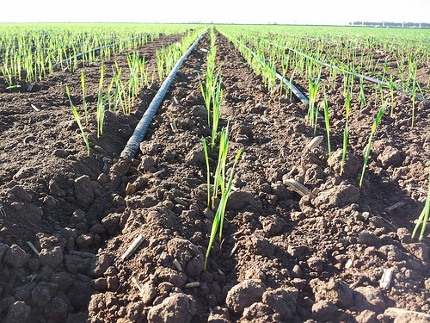Drip irrigation could dramatically reduce water use in Pakistan, but uptake of the technology is being hampered by high costs and lack of awareness

Liaquat Ali says he is happier than he was five years ago. That was when the farmer from Hatoongo village, in the arid district of Sanghar in Pakistan’s Sindh province, gave up using conventional irrigation methods and switched to drip irrigation. The technology has allowed him to double the amount of land he cultivates. He now grows lemons, olives and vegetables on his one-acre patch and sells his produce in the market.
Ali’s village in Sindh province does not have access to the country’s irrigation system. The climate is arid with sandy soil with low rainfall. “Farming on sandy soil is not just difficult, it is a gargantuan and costly affair,” said Ali. “We have to water every other day as the soil just guzzles all the water.”
Drip irrigation saves water by allowing both water and chemicals to drip slowly and directly to the roots of plants through a network of valves and pipes.
According to Dr Pervaiz Amir, a leading environmental and agricultural expert, drip irrigation is best for drylands and coastal areas where there is a shortage of water. It allows water to be applied with precision and little wastage and water requirement can be reduced by 35 to 40%.
About five years ago, when Ali put up the drip irrigation system on his one acre, the cost was Rs. 75,000 (US$765) per acre, said Liaquat Panhwar, a spokesperson for the Sindh Agricultural and Forestry Workers Coordinating Organisation (SAFWCO ),an NGO which has helped install the system for small farmers over 100 acres in Sanghar district since 2007.
“We bear 80% of the expense and the farming community the remaining 20% which includes labour,” Panhwar told thethirdpole.net. He said Sanghar was chosen because it was among the least developed areas of the country and largely desert. “We felt the poor farming communities needed to increase irrigation efficiency and water losses caused by evaporation and absorption of the sandy soil,” he added.
Along with laying the network of pipes, SAFWCO also built reservoirs where rain water can be stored and used for irrigation purposes.
Over the years, Panhwar has noticed the benefits of drip irrigation for bringing sandy land under cultivation. He says the new technology has increased yields per acre by 40%, allowed farmers to cultivate more land using less water, and reduced the hours needed to irrigate crops.
As for Ali, he has not only installed drip irrigation, but also eliminated dirty diesel fuel from his life by installing a windmill. This has further reduced the cost of pumping water from wells.
In a nearby village of Morjo, Mir Hasan’ s two acres of land is strewn with thin, long, black pipes. Agreeing with Ali, he says the cost of cultivation has reduced considerably. “What I have noticed is that though I still use diesel to run the motor to get water from the tubewell, the land is watered in just 15 minutes; earlier it would take us hours and the soil remained parched,” he said.
But Pervaiz Amir believes the technology is too expensive to have widespread application. “It is mainly useful for orchards and vegetables and flowers but not very useful for grain crops,” he said.
However, the drought currently ravaging southeast Pakistan may increase the impetus behind drip irrigation in the district. Last week the Sindh government declared nine districts in the state as drought-hit, including Sanghar. This came following the deaths of over a hundred children amid drought in Tharparkar due to malnutrition and lack of healthcare.
Low productivity and water wastage
According to the Pakistan Economic Survey of 2012-13, agriculture contributes 21% to the country’s gross domestic product and employs 45% of the country’s labour force.
Yet the country’s agricultural productivity is the lowest in the world.
A 2011 report by the United Nations Food and Agriculture Organisation (FAO) found Pakistan’s productivity to be behind regional as well as global yields per acre for nearly all crops including wheat, rice, sugarcane and pulses. Despite being among the ten major producers of wheat in the world, Pakistan’s per hectare yield is only 2.6 tonnes compared to India’s 2.8 tonnes and China’s 4.7 tonnes.
One reason for the low yield is shortage of water. According to the Asian Development Bank (ADB), “Pakistan is one of the most water-stressed countries in the world, not far from being classified as water scarce, with less than 1,000 cubic metres per person per year.”
A recent ADB report said that “agricultural productivity could be doubled with appropriate reform. Improved water management is critical to deliver sufficient water to the 80 percent farmland in the country that is irrigated through a canal system.”
There are many other ways Pakistan could save water, such as water recycling. In Israel, for example, more than 50% of water used in agriculture comes from treated sewage.
Sadly flood irrigation still remains the popular method with just 0.10% of cultivated land irrigated through drip irrigation. Amir doubts the drip irrigation will ever cover more than 2% of land in Pakistan. Panhwar puts this poor response to something that can be so beneficial down to lack of awareness and technical support.
Another big deterrent is the initial cost incurred argues Panhwar. In Sindh province, he says, only big landlords with hundreds of acres of land can afford to set this up. “Along with that,” adds Amir, “pipes clog with brackish water and need replacement after a few years.”
